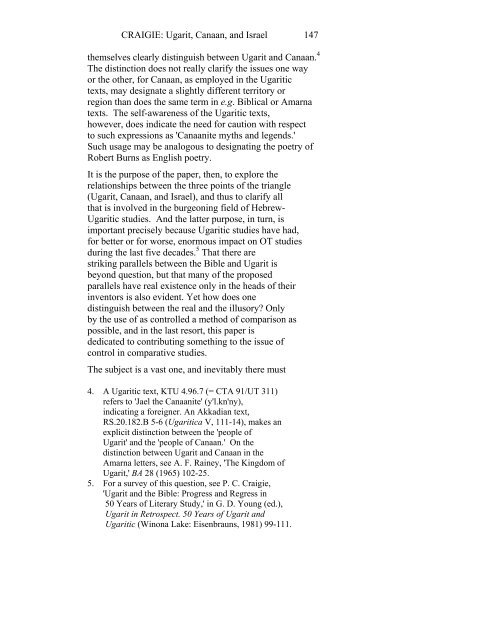UGARIT, CANAAN, AND ISRAEL.pdf - Tyndale House
UGARIT, CANAAN, AND ISRAEL.pdf - Tyndale House
UGARIT, CANAAN, AND ISRAEL.pdf - Tyndale House
Create successful ePaper yourself
Turn your PDF publications into a flip-book with our unique Google optimized e-Paper software.
CRAIGIE: Ugarit, Canaan, and Israel 147<br />
themselves clearly distinguish between Ugarit and Canaan. 4<br />
The distinction does not really clarify the issues one way<br />
or the other, for Canaan, as employed in the Ugaritic<br />
texts, may designate a slightly different territory or<br />
region than does the same term in e.g. Biblical or Amarna<br />
texts. The self-awareness of the Ugaritic texts,<br />
however, does indicate the need for caution with respect<br />
to such expressions as 'Canaanite myths and legends.'<br />
Such usage may be analogous to designating the poetry of<br />
Robert Burns as English poetry.<br />
It is the purpose of the paper, then, to explore the<br />
relationships between the three points of the triangle<br />
(Ugarit, Canaan, and Israel), and thus to clarify all<br />
that is involved in the burgeoning field of Hebrew-<br />
Ugaritic studies. And the latter purpose, in turn, is<br />
important precisely because Ugaritic studies have had,<br />
for better or for worse, enormous impact on OT studies<br />
during the last five decades. 5 That there are<br />
striking parallels between the Bible and Ugarit is<br />
beyond question, but that many of the proposed<br />
parallels have real existence only in the heads of their<br />
inventors is also evident. Yet how does one<br />
distinguish between the real and the illusory? Only<br />
by the use of as controlled a method of comparison as<br />
possible, and in the last resort, this paper is<br />
dedicated to contributing something to the issue of<br />
control in comparative studies.<br />
The subject is a vast one, and inevitably there must<br />
4. A Ugaritic text, KTU 4.96.7 (= CTA 91/UT 311)<br />
refers to 'Jael the Canaanite' (y'l.kn'ny),<br />
indicating a foreigner. An Akkadian text,<br />
RS.20.182.B 5-6 (Ugaritica V, 111-14), makes an<br />
explicit distinction between the 'people of<br />
Ugarit' and the 'people of Canaan.' On the<br />
distinction between Ugarit and Canaan in the<br />
Amarna letters, see A. F. Rainey, 'The Kingdom of<br />
Ugarit,' BA 28 (1965) 102-25.<br />
5. For a survey of this question, see P. C. Craigie,<br />
'Ugarit and the Bible: Progress and Regress in<br />
50 Years of Literary Study,' in G. D. Young (ed.),<br />
Ugarit in Retrospect. 50 Years of Ugarit and<br />
Ugaritic (Winona Lake: Eisenbrauns, 1981) 99-111.
















